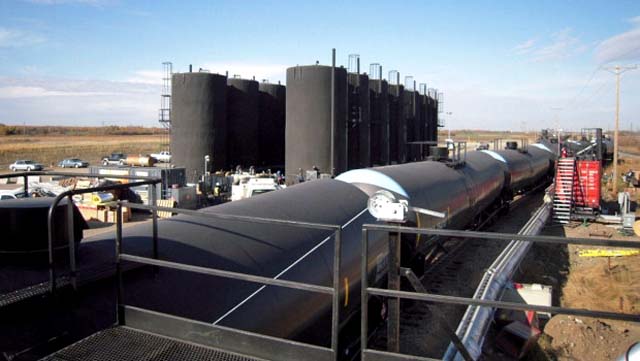
2012
|


An oil trans-loading facility - Date/Photographer unknown.
25 July 2012
City Will Continue to Press CPR to Move Facility
Estevan Saskatchewan - The initial furor has died down but the City of Estevan is still continuing to press Canadian Pacific Railway to
move its oil trans-load facility outside of city limits.
CPR opened the facility in December much to the chagrin of City officials and the Estevan Fire Rescue Service who expressed concerns about increased heavy
truck traffic, the subsequent damage to local roads, and potential safety concerns.
Although the sides have agreed to live with one other for the time being, at a recent meeting the members of council reiterated their desire to see the
trans-load site moved out of Estevan as soon as possible.
Located on CPR's property in the centre of town, the trans-load site allows tanker trucks to off-load crude oil onto oil tankers which are then shipped to
another location. The operations at the site have since been expanded to include the trans-loading of fly ash.
The City and CPR have held a number of meetings since the facility opened and CPR has stated in the past if the number of tanks they transport increased
dramatically they would look into moving the site by the third quarter of 2013.
"As I said to council, we have to keep the pressure on them to make sure they move out," Mayor Gary St. Onge said in a recent interview. "They
are looking at three places, one west, and two east."
Kevin Hrysak, the manager of media relations and public affairs for CPR, said the company is continuing to review sites in the area as well as checking into
the feasibility of any kind of move.
He added that although the third quarter of 2013 has been mentioned as the time for a possible move, CPR is still loading just six to eight carloads a week,
numbers that likely would not warrant a move.
"The 2013 date was when we were talking about up to 15 carloads a day of business," Hrysak said. "Once we would get to that level, we would
obviously outgrow the current location we are in. But we haven't increased any capacity. Once our business does outgrow the capacity at the current location
we'd be in a position to relocate to another area. But at the present moment, we have not seen an increase in business, we are still five or six to eight
carloads a week."
With respect to the fly ash at the site, they are currently loading three to four rail cars a day, which has two trucks making eight to 12 trips per day.
St. Onge said they would also like to see CPR move their pipe trans-loading operations, which they also conduct in the city, to any new facility out of town.
As it currently stands, pipe is hauled to the city and then offloaded at locations along Sixth Street. St. Onge said the City has plans to rebuild and pave the
section of Sixth Street from Souris Avenue to Kensington Avenue and would like the trucks to be off the street when the work is done.
"We are supposed to start on Sixth Street this year," said St. Onge who added the current method causes a handful of headaches for the City on Sixth
Street.
"We have surface drainage and they don't have any approaches onto their property. So trucks load right down in the ditch basically and that has wrecked
the drainage. They should be building approaches so that you can drive in there and load right on their property because even if we fix it, it is not going to
last long if they are still loading there."
Author unknown.

|


|
Vancouver Island
British Columbia
Canada
|
|


